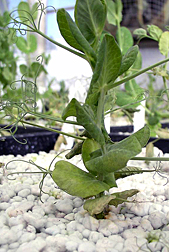Washington, DC, USA
November 21, 2013

Photo, Rebecca McGee, ARS.
New garden- and dry-pea breeding lines developed by U.S. Department of Agriculture (USDA) scientists and their collaborators may offer growers added insurance against Aphanomyces root rot, a disease that can cause crop yield losses of 20 to 100 percent.
The mold-like pathogen that causes the disease, Aphanomyces euteiches, infects the roots and underground stems of susceptible pea plants and other legumes, rotting them and causing stunted growth, lesions, wilted leaves and other symptoms. Fungicides aren't an option, so growers must either avoid planting in fields with a history of the disease or switch to growing non-host crops until pathogen numbers drop to acceptable levels.
However, avoidance and crop rotation may not always be economically feasible. Furthermore, breeding peas for resistance to Aphanomyces has proven difficult because multiple genes are involved, according to Rebecca McGee, a plant geneticist with USDA's Agricultural Research Service (ARS), USDA's principal intramural scientific research agency.
The resistance genes are also associated with undesirable traits, which cultivated varieties can inherit when crossed with wild germplasm sources, adds McGee, at the ARS Grain Legume Genetics Physiology Research Unit in Pullman, Wash.
As an alternative, McGee, ARS geneticist Clare Coyne and other colleagues sought to develop pea germplasm lines that naturally tolerate the pathogen, but do not suffer the same ill effects as susceptible plants—particularly not significant yield losses. Coyne is with the ARS Plant Germplasm Introduction and Testing Research Unit, also in Pullman.
The pea lines are descendants of an inbred population of plants derived from an ARS cross made in 1993 between the cultivar Dark Skin Perfection and germplasm line 90-2131. Besides their tolerance of Aphanomyces root rot, the lines were also chosen for their acceptable agronomic characteristics.
Incorporating the tolerance trait into elite varieties could prove especially beneficial to growers in Pacific Northwest and North Central states, where Aphanomyces outbreaks threaten the valued role that peas and other legumes play in cereal-based crop rotation systems.
Read more about this research in the November/December 2013 issue of Agricultural Research magazine.
Científicos desarrollaron plantas de judías que tienen resistencia a una enfermedad grave
Nuevas líneas de plantas de judías desarrolladas por científicos del Servicio de Investigación Agrícola (ARS) y sus colaboradores podrían ayudar a los productores de judías a proteger su cultivo contra la pudrición de raíces causada por el patógeno Aphanomyces euteiches. Esta enfermedad puede reducir los rendimientos del cultivo de judías hasta el 100 por ciento.
El patógeno infecta las raíces y los tallos subterráneos de las plantas de judías y otras legumbres. Esta infección reduce el crecimiento de la planta, causa lesiones necróticas y la marchitez de las hojas, y otros síntomas. Los productores tienen que abandonar los campos infectados o cultivar otros cultivos hasta que el número de patógenos en el campo disminuyan a niveles aceptables.
Sin embargo, la evitación y la rotación de cultivos algunas veces no son factibles económicamente. Además, criar las plantas de judías para desarrollar resistencia a Aphanomyces ha sido difícil porque hay múltiples genes que tienen un papel en la resistencia, según Rebecca McGee, quien es genetista de plantas con el ARS. ARS es la agencia principal de investigaciones científicas del Departamento de Agricultura de EE.UU. (USDA por sus siglas en inglés).
Los genes que proveen resistencia también son asociados con algunos rasgos no deseables. Las variedades comerciales pueden heredar estos rasgos del germoplasma silvestre cuando se cruzan las variedades, según McGee, quien trabaja en la Unidad de Investigación de la Fisiología y Genética de Legumbres y Granos mantenida por el ARS en Pullman, Washington.
McGee colaboró con genetista Clare Coyne y otros científicos para desarrollar líneas de plantas de judías que tienen una tolerancia natural al patógeno, pero no sufren de los mismos efectos adversos como las plantas vulnerables, particularmente las reducciones en rendimientos. Coyne trabaja en la Unidad de Investigación de la Introducción y Evaluación de Germoplasma de Plantas mantenida por el ARS en Pullman.
Las nuevas líneas de plantas de judías son descendientes de una población endogámica de plantas derivadas de un cruce realizado en el 1993 entre la variedad 'Dark Skin Perfection' y la línea de germoplasma 90-2131. Además de su tolerancia de la pudrición de raíces causada by Aphanomyces euteiches, las líneas también ofrecen características agronómicas deseables.
Incorporar la tolerancia al patógeno en las variedades podría ser muy beneficioso para los productores en los estados del Pacífico-Noroeste y la parte norte-central de EE.UU., donde hay brotes de Aphanomyces que amenazan el papel importante de judías y otros legumbres en sistemas de rotación de cultivos.
Lea más sobre esta investigación en la revista 'Agricultural Research' de noviembre-diciembre del 2013.